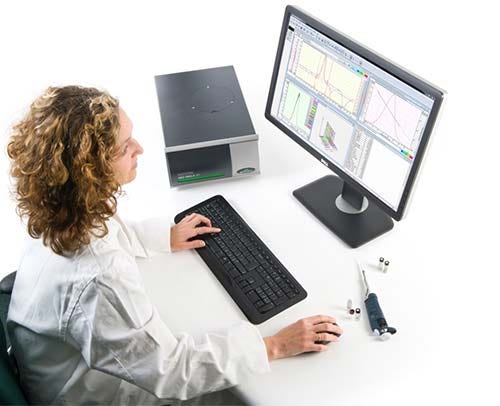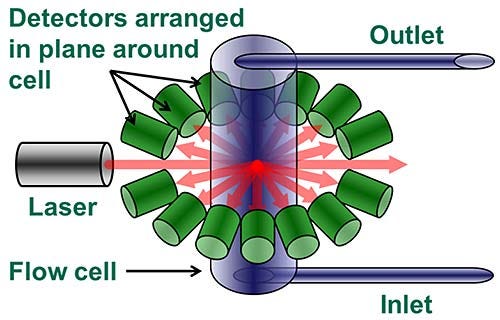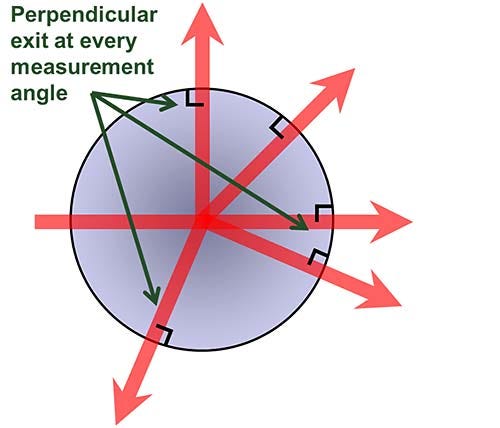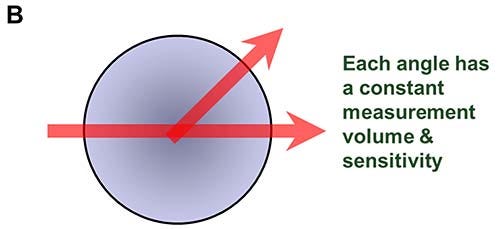The Viscotek SEC-MALS 20 is a 20 angle multi-angle light scattering detector for the measurement of molecular weight and radius of gyration, Rg. It is designed for the characterization of natural and synthetic polymers and proteins. The hardware inside the SEC-MALS 20 contains a number of technical advantages that place its performance above other MALS detectors.
This technical note briefly describes these advantages.

|
The SEC-MALS 20 contains a flow-cell that is arranged vertically within the system. The chromatographic flow enters at the inlet at the bottom of the cell and flows upwards to the outlet. The laser is arranged horizontally so that the incident light passes through the center of the cell. The different detectors are arranged around the cell in the same plane as the laser. A schematic of this design is shown in figure 2 and the setup is known as a 'vertical flow cell with radial optics'.

|
This design affords the measurement a number of advantages:
Whilst the number of angles in a MALS detector is not the primary factor in the accuracy of the data, it is a reasonably well accepted argument that the more angles a system contains, the more accurate the molecular weight will be. The reasoning behind this is that the more data points that can be plotted on the Debye plot, the more accurate the fitting will be. With 20 measurement angles, the Viscotek SEC-MALS 20 has more angles than any other system on the market for SEC enabling the most accurate data fits and the highest quality results.
However, it is the accuracy of the extrapolation to 0° that ultimately leads to more accurately calculated molecular weight and Rg values and whilst more angles are important it is the lowest angles that are most important.
When fitting a model to data from anisotropically scattering samples, it is most important to understand how the scattered light is behaving at low angles because these low angles have the greatest effect on where the fit line will intersect the y-axis of the Debye plot and thus the calculated molecular weight. They will also strongly affect the calculated Rg since this is taken from the initial slope of the line, i.e. the slope of the line close to the axis.
When considering these points, it becomes clear that the number of low angles is actually more important than the overall number of angles with respect to accurately measuring molecular weight and Rg. The SEC-MALS 20 has more functioning angles <90° than any other system on the market for SEC, again contributing to more accurate fits and more accurate results.
A circular vertical flow cell also allows measurements to be made at any angle without the data becoming much noisier at lower angles. Noise, flare, and refractive index effects all reduce signal-to-noise. When light passes through a cell wall at a shallow angle, these effects are worsened. When looked at from a top-down perspective (figure 3), it can be seen that the scattered light in the SEC-MALS flow cell always exits the cell at an angle perpendicular to the cell wall. This means that the amount of noise from the cell is constant and low at all angles thereby maximizing the instrument signal-to-noise.

|
A second source of potential noise within a MALS system comes from where the laser intersects regions of turbulent flow. Any contaminants that enter the system are likely to build up in these areas as they are not cleared by the flow. If the laser intersects these regions, then those contaminants will scatter light and add noise to the system. By positioning the measurement volume of the SEC-MALS away from regions of turbulent flow and in a region of laminar flow (figure 4), any noise contribution from these contaminants is removed to, again, reduce noise.

|
The final benefit of the vertical flow cell comes from the level of confidence that can be achieved from the measurement.
If the flow cell is arranged horizontally with a lens, and the scattered light exits the cell at an angle other than 90° (figure 5A) then the actual measurement position will change with refractive index of the mobile phase. This means that the measurement volume will change and the sensitivity will also change. All of these issues are avoided by using the vertical flow cell option (figure 5B).

|

|
The Viscotek SEC-MALS 20 is an improvement in MALS design in a number of ways.
With these advantages, the SEC-MALS 20 is able to maximize signal and minimize noise to make the most accurate measurements of molecular weight and Rg.